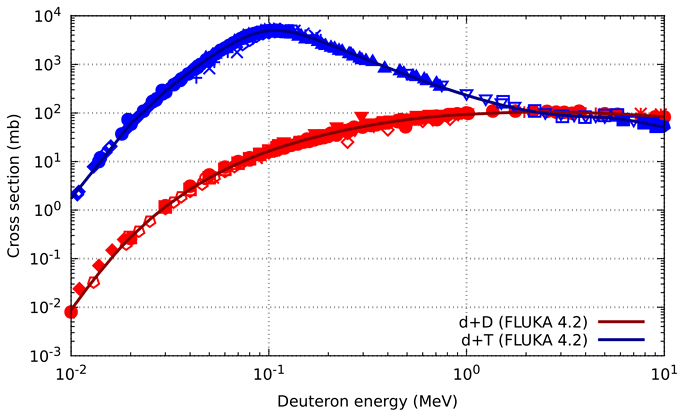Dear Irina,
Your problem should indeed be treatable in FLUKA 4.2, but you should carefully consider the points and warnings below.
Your input contained the following main errors:
- The LOW-MAT cards should assign cross sections to H-2 and C-12 respectively (not CD2).
- Comment out the IONTRANS with DEUTERON
- You don’t really need the PHYSICS card with the LOWDEU and WHAT(1)=0, as this is anyway the default. The intention of the card is to be able to switch off the low-energy-d interaction model if ever desperately needed (misbehavior etc).
- Forget the PHOTONUC card (one would not expect to see photons with ~10s of MeV here)
- Forget the LOW-NEUT card (you ask anyway for the defaults).
- The PART-THR cards for PHOTON and ELECTRON are ineffective (the thresholds for these particles go rather through the EMFCUT).
- In the PART-THR for d you can put e.g. 1e-5 GeV.
- You can comment out the PART-THR for neutrons.
Note that your geometry is immersed in air: 600 keV deuterons will undergo electronic stopping, so their energy upon arrival on the slab will critically depend on where your beam starts. You may want instead
to put vacuum.
Thin (say, down to a micron) targets should not be a problem per se in FLUKA. There is one physical consideration to make though: if you look at the output file you’ll see a table with the inelastic scattering
lengths for deuterons on various materials. You’ll see that deuterons (at the beam energy) undergo one nuclear inelastic interaction in your CD2 every 70 cm or so. Considering that your target is 2 um thick, this begs for a LAM-BIAS card, shortening the inelastic scattering length of primary deuterons by a factor say 1e-5 (otherwise you’d need to sample for an excessively long time to even begin to see nuclear inelastic interactions). Consider using SDUM=INEPRI to bias only the primary deuterons.
Increase the number of primaries to e.g. 10000 (and beyond once you’re sure things run).
What do you want to score exactly? If you wish to look at the production of residual nuclei, add a RESNUCLE card. You’ll witness radioisotope production (as opposed to previous versions of FLUKA, where even with the IONSPLIT recipe one would not score any residual nuclei!).
If you care about prompt radiation (mainly n, I presume), you should be able to see it as well, e.g. with a USRBDX card scoring one-way fluence of say neutrons from the target onto the void/air.
One warning: whereas the reaction cross section for d+D should be reasonable, the parametrization for the reaction cross section of d on heavier nuclei (including C) can suffer from considerable uncertainties
at such low deuteron energies.
Note that although the recently included model for low-energy deuterons has been reasonably tested (especially for target nuclei with atomic number Z>2 and mostly for energies above a few MeV, for which it was conceived), its performance on deuterium, tritium, and helium targets is still tentative, as disclaimed in the RELEASE-NOTES.
For all of the above It would be advisable to put a sizeable safety margin on top if you use it for your estimates.
With kind regards,
Cesc
